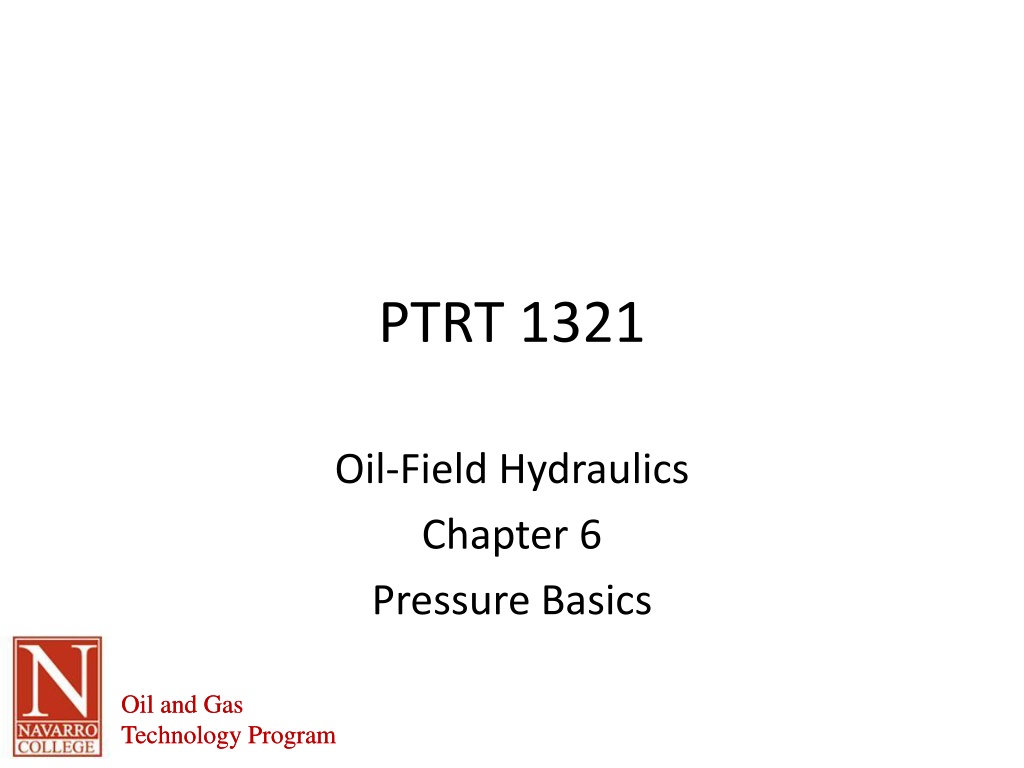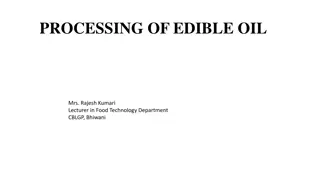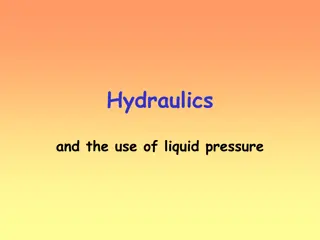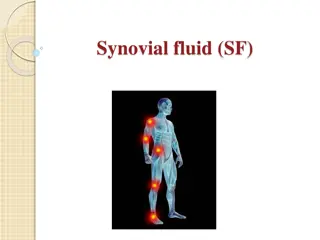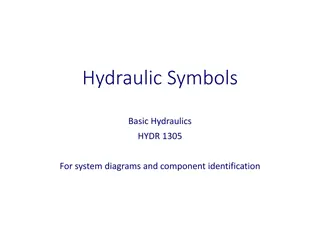Understanding Fluid Pressure in Oil Field Hydraulics
Explore the fundamentals of fluid pressure including pressure basics, unit conversion, fluid weight constants, true vertical depth, and hydrostatic pressure in the context of oil and gas technology programs. Learn how to calculate pressure gradients, understand the impact of fluid density on pressure, and determine hydrostatic pressure based on true vertical depth. Discover the essential concepts that underpin efficient oil field hydraulics operations.
Uploaded on Apr 06, 2024 | 1 Views
Download Presentation

Please find below an Image/Link to download the presentation.
The content on the website is provided AS IS for your information and personal use only. It may not be sold, licensed, or shared on other websites without obtaining consent from the author. Download presentation by click this link. If you encounter any issues during the download, it is possible that the publisher has removed the file from their server.
E N D
Presentation Transcript
PTRT 1321 Oil-Field Hydraulics Chapter 6 Pressure Basics Oil and Gas Technology Program Technology Program Oil and Gas
Pressure Basics Force Force But: Stored energy is different and relies on compression Oil and Gas Technology Program
Fluid Pressure Fluids exert pressure Pressure in a column of fluid arises from density (weight of the column) Pounds per gallon (ppg or lb/gal) or pounds per cubic foot (pcf or lb/ft3) Pressure Gradient - Pressure at depth is often described with psi/ft. This is the pressure generated for each foot of fluid depth. Oil and Gas Technology Program
Unit Conversion Weight of the fluid column result in a certain psi/ft depending on the density of the fluid requires a conversion factor Constant = C PG = pressure gradient FW = fluid weight (ppg or pcf) C = constant (will be different number for ppg or pcf) C = 0.052 when fluid weight is expressed in ppg C = 0.00694 when fluid weight is expressed in pcf Oil and Gas Technology Program
Fluid Weight Constants Volume has three dimensions Picture a volume that is 1 cubic foot 12 x 12 x 12 Also we know (by looking it up) that one cubic foot = 7.48 gal Therefore this gallon weighs 7.48 lbs The pressure at the base is then 7.48/144 lbs/sq ft = 0.052 psi/ft Oil and Gas Technology Program
Oil and Gas Technology Program
True Vertical depth Gravity pulls down (only). This means the vertical depth is the only source of pressure exerted by the column of fluid Directionally drilled holes might have measure depth that is much greater than the vertical depth ONLY the True Vertical Depth (TVD) matters for calculations Oil and Gas Technology Program
Hydrostatic Pressure Hydro = water or fluid static = not moving HP = Hydrostatic Pressure (psi) PG = Pressure Gradient (psi/ft) TVD = true vertical depth (ft) Example: PG = 0.478 psi/ft and TVD = 6,130 ft. Then HP = 0.478 x 6130 = 2930 psi Oil and Gas Technology Program
A more complicated example Assume: TVD = 12,764 ft filled with a fluid that weighs 15 ppg (density) What is the hydrostatic pressure at the bottom of the well? 1. Find Pressure Gradient. PG = 0.052 x 15 ppg = 0.78 psi/ft 2. Now find Hydrostatic Pressure. HP = PG x TVD = 0.78 x 12,764 = 9,956 psi Hydrostatic pressure must be greater than or equal to the formation pressure to prevent well kick when not pumping Oil and Gas Technology Program
In Class Assignment Assume: TVD = 10,000 ft filled with a fluid that weighs 10 ppg (density) Calculate the hydrostatic pressure at the bottom of the well? Place your name on the paper and turn in your work. Oil and Gas Technology Program
The Well as a U-tube Work string is one leg of the U-tube Casing annulus is the other leg If both legs are open to atmosphere the pressure in both is the same and no fluid flows Suppose that the work string has 10.2 ppg fluid in it and the casing has 10 ppg fluid in it. Pressure differential is created Oil and Gas Technology Program
10.2 ppg 10 ppg Well simulation Pressure Differential Oil and Gas Technology Program
Gauge vs. Atmospheric pressure Hydrostatic pressure at the bottom of a well also includes the atmospheric pressure Check you gauges psi means atmospheric pressure has been calibrated out psig means atmospheric pressure is still there Usually doesn t matter since 14.7 is small and there is fluid in both the tubing and casing and we re dealing with pressure differences (see next section) Oil and Gas Technology Program
Example Assume well is 10,000 ft TVD and we use the previous fluids in the work string and casing HPworkstring = 10.2 x 10,000 x 0.052 = 5,304 psi HPcasing = 10 x 10,000 x 0.052 = 5,200 psi Pressure Differential = 5,304-5,200 = 104 psi Oil and Gas Technology Program
Formation Pressure Fluid in formation reside in pores Connected pores result in permeability Formation pressure is the pressure of the fluids contained within the pores Normal pressure equals that calculated by the depth of the fluid column varies by region (depends on salinity) Pressure gradient typically between 0.433 0.465 psi/ft Subnormal gradient less than fresh water can occur naturally in mountainous regions or from the production of formation fluids Abnormal gradient larger than 0.465 psi/ft sealed formations squeezed by shale or other overlying strata Fluids are pressurized and can require fluid weights exceeding 20 ppg to control. Overburden pressure is equal to about 1 psi/ft Oil and Gas Technology Program
Fracture Pressure Amount of pressure a formation can withstand before it fails (fractures) Hydraulic pressure must exceed the formation pressure before fluid can enter the formation Expressed as: pressure (psi) Fracture gradient (psi/ft) Fluid-weight equivalent (ppg) Often convenient to convert fracture gradient to equivalent fluid weight 0.754 psi/ft 0.052 = 14.5 ppg Oil and Gas Technology Program
Fracture Gradient Fracture Gradient typically increases with depth Loosely compacted or shallow formations can have low fracture gradients Exceeding fracture gradient can allow well pressure to vent into formation (lost circulation) Can also undermine the surface strength under the rig Fracture gradient knowledge is important wherever the fluid pressure is contacting a formation for instance just below the surface casing Oil and Gas Technology Program
Formation Integrity Tests Fracture pressure is determined using a leak- off test (LOT) or pressure integrity test (PIT) Determines: Adequate seal between casing and formation Maximum pressure (fluid weight) that the well bore can withstand Several factors to keep in mind Fluid should be circulated Check to ensure at required weight and homogeneous (uniform) High-pressure/low volume pump Oil and Gas Technology Program
Leak-off Tests (LOT) Pressure increased in 100 psi increments at bbl volume steps Stop pump and hold pressure for about 5 minutes If pressure holds bump up another 100 psi and check again As you approach the fracture pressure the pressure will drop off during the hold time Alternative approach is to circulate fluid through a choke close the choke so that you achieve 100 psi increments monitor fluid volume until fluid is lost to formation (small volume tank) Appears to yield a lower fracture pressure but friction losses do not show on the graph Oil and Gas Technology Program
A = no fluid loss B = start of fluid loss C = fracture pressure Oil and Gas Technology Program
Pressure-integrity Tests (PIT) Performed when it s unacceptable to actually fracture the formation Use data from nearby wells in the same formation to estimate the maximum pressure the well can maintain without fluid loss (breakdown) Pressure up the well to this level (or any other level below it) and check that it holds pressure Oil and Gas Technology Program
Maximum Fluid Weight and Surface Pressure Knowing the formation-integrity test results provides an opportunity to calculate: Maximum fluid weight Maximum pressure These are the values the formation can withstand without fracturing Oil and Gas Technology Program
Maximum Fluid Weight ( ) Oil and Gas Technology Program
If Hole is Deepened after LOT or PIT Oil and Gas Technology Program
LOT performed at TVD 5,821 ft Leak-off = 1,250 psi w/ 9.6 ppg fluid Now deepened to 11,226 ft Fluid now in well is 10.1 ppg Example ( ) ppg To find maximum pressure that can now be applied Oil and Gas Technology Program
Equivalent Fluid Weight Regs or operator may require test to a certain equivalent fluid weight Oil and Gas Technology Program
Example TVD is 5,745 ft filled with 9.1 ppg fluid How much pressure should be applied to yield an equivalent fluid weight of 13.4 ppg? Oil and Gas Technology Program
Equivalent Fluid Weight at Casing Shoe Formation exposed to well bore directly below the casing shoe is most likely to fracture Equivalent fluid weight that fractures the formation at the shoe can help ensure that fracturing does not occur Assuming the shut-in pressure can be obtained from a casing gauge on the shut- in well: Oil and Gas Technology Program
( ) Example: Casing Shoe at 3,005 ft. Well is filled with 8.8 ppg fluid Shut-in casing pressure = 375 psi ) ( Oil and Gas Technology Program
Circulating Pressure Losses Friction resistance to movement Density Roughness of contact surface Surface area Surface properties Force needed to overcome friction is called the frictional loss For fluids typically measured in psi Can amount to thousands of psi Oil and Gas Technology Program
Oil and Gas Technology Program
Circulating Pressure Losses When fluid returns to surface will be at or near 0 psi Pressure at the pump is almost entirely used to overcome frictional losses during circulation In well control the most important pressure loss to consider is that which occurs in the annulus as this determines the BHP When circulation stops BHP is reduced by the pumping pressure required to raise the fluid up through the annulus If hydrostatic pressure alone is not sufficient to balance formation pressure then fluids will enter the well bore Oil and Gas Technology Program
Equivalent Circulating Density Friction losses in the annulus increase the BHP They equally increase the effective fluid weight Both of these are akin to backpressure Additional fluid weight caused by circulation is called ECD Oil and Gas Technology Program
Oil and Gas Technology Program
Determining ECD Oil and Gas Technology Program
Oil and Gas Technology Program
Swabbing and Surging Swabbing suction produced by tripping out i.e. plunger on a syringe Surging pressure produced with the string is lowered too fast and the fluid can t get out of the way Both affected by: Rate of movement Clearances Fluid properties Friction Viscosity Suspended solids (inertia) Oil and Gas Technology Program
Trip Margins Often a safety factor added to compensate for swabbing Often equal to the circulating pressure to lift fluid up the annulus Too large can cause lost circulation Too small can allow the well to kick Oil and Gas Technology Program
Bottom Hole Pressure (BHP) Hydrostatic pressure accounts for most of the BHP Annular pressure adds to this when circulating usually less than 200 psi Additional back pressure terms add to BHP as well Rotating head choke Oil and Gas Technology Program
Differential Pressure Difference between BHP and formation pressure Overbalanced: BHP > formation pressure Underbalanced: BHP < formation pressure Balanced: BHP = formation pressure Never forget the importance of human pressure in well control understanding is the key Oil and Gas Technology Program
